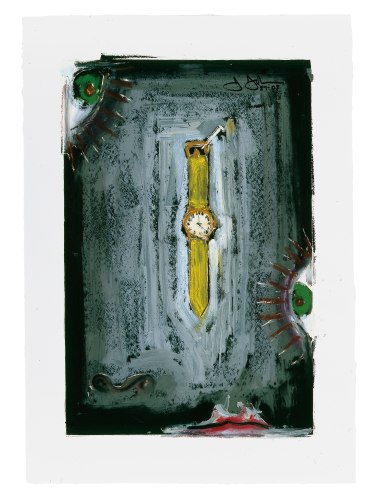
Jasper Johns, Untitled, 1987/2008
Pigment stick over intaglio
24 1/4 x 17 inches
For today's blog, we invited Pepe Karmel to write about Jasper Johns' Untitled, 1987/2008. Pepe Karmel is an Associate Professor of Art History at New York University.
At the top of Georges Braque’s early 1910 Violin and Pitcher, a crudely drawn nail projects from the wall, providing something solid for the viewer to hang onto as the objects below dissolve into a torrent of coruscating facets. Braque’s nail reappears in the 1987 etching by Jasper Johns that provides the underlying composition for his untitled drawing of 2008.
At the center of the image, a wristwatch is suspended from the nail. This everyday motif is surrounded by a frame of surpassing strangeness: a wide-open eye at top left, another eye on the right edge, stylized lips at bottom right, and a calligraphic nose -- nostrils and tip– at lower left. Johns began using this frame in drawings, prints, and paintings around 1984 and continued through at least 1995. He originally explained the redistribution of the facial features in these pictures as inspired by Pablo Picasso’s 1936 painting Straw Hat with Blue Leaf. Later he suggested that the arrangement might have also been influenced by illustrations in an essay by Bruno Bettelheim that he had read many years earlier, “Schizophrenic Art: A Case Study,” published in the April 1952 issue of Scientific American.
Bettelheim recounts the history of a girl who retreats into schizophrenia after her father dies and her mother, consumed by melancholy, neglects her. Slowly and painfully, the girl cures herself by weaving a narrative of nurturing and being nurtured to compensate for the reality of being abandoned by her parents. In one of the drawings that she makes as part of the therapeutic process, a house beneath a dark sky represents the school where she receives treatment; the sun tentatively appears in the upper left corner, but its rays fail to dispel the darkness. In another, she imagines nursing at her mother’s breasts: here, schematic eyes, nose, lips and breasts are distributed quasi-randomly across a pink field.
The eye in the upper left-hand corner of Johns’ 1987 etching echoes the sun in the “house” drawing. It also recalls the midnight sun/hanging lamp of Picasso’s Guernica. The figuration of the eyes, mouth and nose is adapted from Straw Hat with Blue Leaf. But the detachment of the facial features from any central form evoking a head, and their radical displacement to the margins of the image, echo the free-floating arrangement of the “nursing” drawing in Bettelheim’s essay.
Johns seems to have been fascinated with Bettelheim’s patient and her drawings because her experience of abandonment resonated with his own memories of childhood. His parents divorced when he was very young. His mother moved away. His father sent him to live with his grandfather and then with an aunt. The watch at the center of the composition belonged to Johns’ father, who promised to give it to him when he was grown up. Impatient, the boy snuck into his father’s house and took the watch. His father promptly reclaimed it, frustrating his son’s desire for connection.
In sum, the imagery of the 1987 etching is unremittingly bleak. The eyes gaze with desperate intensity on the watch. Inches away, it occupies the center of the composition. But the disembodied consciousness of the shattered self is incapable of touching it.
And yet the 2008 drawings made over proofs of the etching are infused with a seemingly innocent joy. In several of them, Johns replaces the gray background with a saturated field of orange or blue, adding clouds of paler colors applied in casual lines and rococo curlicues. In others, he scumbles vertical white streaks over a gray or black ground. His technique here recalls Braque’s paintings of the 1920s. Where the Impressionists and Fauves painted on white grounds to increase the luminosity of their colors, Braque used dark grounds to make his colors richer and more saturated. In several of the 2008 drawings, a dramatic black shadow to the right of the watch strap provides an unmistakable reference to Braque’s canonical nail.
In the present example, the background is covered with vertical and horizontal strokes modulating from black to gray green to light gray. The watch strap is acidic yellow. The bezel and the clasp are orange. The progression of colors and shades reaches a crescendo in the circular white face. Watch and strap glow with uncanny radiance against the cooler colors around them. They have been transformed from a symbol of parental neglect and indifference into a spiritual presence.
William James devotes the third chapter of Varieties of Religious Experience (1902) to “The Reality of the Unseen.” Among other examples, he cites the testimony of a clergyman who wrote:
My soul opened out, as it were, into the Infinite, and there was a rushing together of the two worlds, the inner and the outer…I stood alone with Him who had made me…I did not seek Him, but felt the perfect unison of my spirit with His. The ordinary sense of things around me faded. For the moment nothing but an ineffable joy and exaltation remained…It was like the effect of some great orchestra when all the separate notes have melted into one, swelling harmony.
A notable feature of this narrative, and the others cited by James in this chapter, is that the writers are not asking for wealth, health or anything else. They are content to experience a brief moment in which the infinite distance between man and his creator disappears. Looking at Johns’ drawing, the viewer may feel the same.
-Pepe Karmel